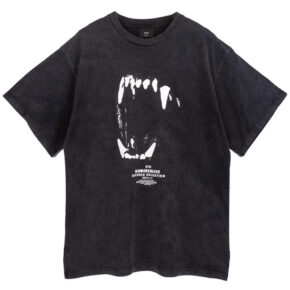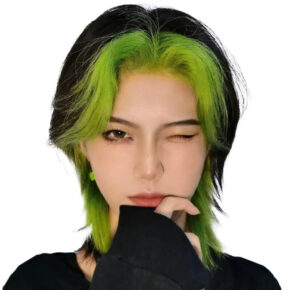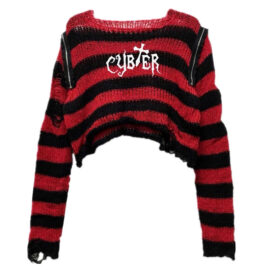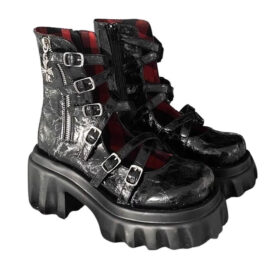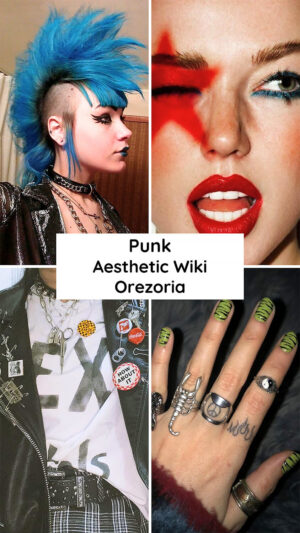
The Punk Aesthetic is a rebellious and unconventional style that emerged in the 1970s as a response to the mainstream cultural norms and values of the time. With its origins in British punk rock, the Punk Aesthetic quickly spread to other countries, taking on various forms and influences.
Characterized by its raw, DIY (do-it-yourself) nature, the visual characteristics of the Punk Aesthetic include ripped clothing, safety pins, band patches, and bold graphic prints. It rejects the notion of conforming to societal standards and instead embraces individual freedom, self-expression, and authenticity.
The impact of the Punk Aesthetic goes beyond just music. It has influenced various art forms, such as fashion, visual arts, and even literature. It has also left a lasting mark on pop culture, shaping the way we perceive subcultures and alternative ideologies.
From the fashion revolution brought about by designer Vivienne Westwood to the politically charged lyrics of punk bands like the Sex Pistols and the Dead Kennedys, the Punk Aesthetic continues to be a powerful force that challenges societal norms and encourages critical thinking.
Related aesthetics: 70s, 80s, 90s, Alternative, Dark Fashion, Doomer, E-Boy, E-Girl, Edgy, Emo, Goth, Grunge, J-Rock, Mallgoth, Skater
Full List of Aesthetics
The History of the Punk Aesthetic
The history of the punk aesthetic can be traced back to the mid-1970s when it emerged as a rebellious subculture in both the United States and the United Kingdom. Originating as a response to the perceived stagnation and commercialization of mainstream music, the punk movement sought to challenge societal norms and advocate for individual freedom and self-expression.
In the United States, bands like the Ramones, the Stooges, and the New York Dolls played a pivotal role in shaping the punk aesthetic. With their raw, stripped-down sound and DIY ethos, they rejected the polished and commercialized sound of the mainstream music industry.
Meanwhile, in the United Kingdom, the Sex Pistols became the face of the British punk movement. Led by the iconic figure Malcolm McLaren, the Sex Pistols embodied the punk aesthetic through their aggressive music, confrontational lyrics, and provocative fashion choices. McLaren’s partner, designer Vivienne Westwood, also played a crucial role in shaping the punk aesthetic with her outrageous and subversive fashion designs.
Punk scenes soon emerged in other countries such as Australia, Germany, and Mexico, each adopting their unique take on the punk aesthetic. These scenes became hubs for artistic expression, activism, and countercultural ideologies.
Today, the punk aesthetic continues to influence various art forms, from music and fashion to visual arts and literature. Its impact can still be seen in the rebellious spirit of punk bands, the fashion choices of subcultures, and the sociopolitical activism embedded in the punk ethos. The punk aesthetic remains a powerful symbol of individuality, DIY creativity, and resistance against conformity.
Key Elements of the Punk Aesthetic
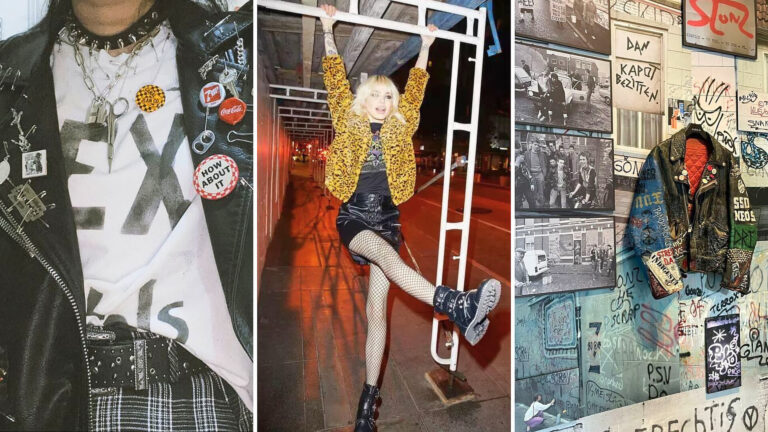
The punk aesthetic is characterized by its graphic expression and visual influences, drawing inspiration from movements such as Dadaist collage and the graphics of counter-culture protest. Punk graphics were an art of expediency, utilizing techniques like collage, hand-lettering, rub-down lettering, and stencils to create their distinctive visual style.
One key element of the punk aesthetic is its rawness and explosive energy. Punk graphics often feature jagged lines, bold colors, and chaotic compositions, evoking a sense of rebelliousness and urgency. The use of distressed textures, torn paper, and cut-and-paste techniques further add to the DIY ethos and rough aesthetic.
Symbols and icons were another important aspect of punk graphics. Safety pins, an emblematic element of punk fashion, frequently appeared in punk artwork, representing both a DIY spirit and a sense of defiance. Band names and provocative slogans were often incorporated into designs, conveying the music and political ideologies associated with the punk movement.
The punk aesthetic also embraced a sense of irony and subversion. The blending of high and low culture, the recontextualization of familiar images, and the use of shock value all played a role in challenging mainstream aesthetic norms and pushing boundaries.
Punk Aesthetic Fashion and Outfits Guide
Punk fashion has long been associated with a distinct aesthetic that embodies rebellion and individuality. From the safety pins and ripped clothing to the bold hairstyles and intense makeup, the punk aesthetic is all about challenging societal norms and expressing oneself authentically. This guide will delve into the various elements that make up punk fashion, from the iconic band t-shirts to the DIY approach of creating unique outfits.
Punk Clothing
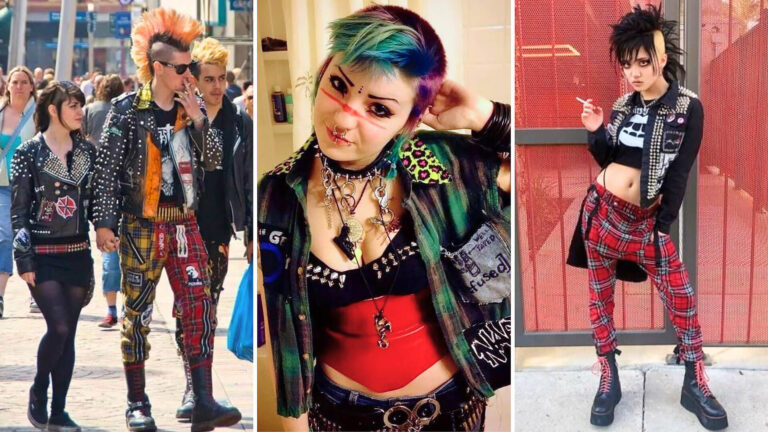
Punk clothing has always been about rebellion and individuality. From the safety pin-adorned shirts and skirts to the unconventional hairstyles, punk girls have made a statement through their fashion choices.
Over the years, punk fashion has evolved and transformed, with each generation bringing its own unique style to the scene. Younger punks have reinvented the punk look, incorporating modern elements while still staying true to the punk aesthetic.
Here are five popular outfits for punk girls:
- The classic punk outfit: A ripped band t-shirt paired with a plaid skirt, fishnet stockings, combat boots, and accessorized with multiple piercings and studded belts.
- The punk rocker outfit: A leather jacket, a graphic punk rock t-shirt, skinny jeans, platform boots, and brightly colored hair.
- The gothic punk outfit: A black lace top, a pleated leather skirt, knee-high boots, fishnet tights, and dark makeup.
- The grunge punk outfit: A flannel shirt tied around the waist, distressed jeans, combat boots, and messy hair.
- The street punk outfit: A cropped punk band t-shirt, high-waisted jeans, Dr. Martens boots or sneakers, and funky accessories like spiked bracelets or chains.
Punk clothing allows girls to express their rebellious and non-conforming nature. It is a style that continues to evolve and inspire new generations, keeping the punk aesthetic alive.
You can find more Punk clothing and accessories in our Punk Outfits Collection.
Try our new Aesthetic Outfits AI to Try-on Clothes.
Punk Accessories and Jewelry
Punk fashion is known for its rebellious and subversive style, and accessories and jewelry play a crucial role in achieving the punk aesthetic. These key pieces not only enhance the overall look but also serve as a form of self-expression and defiance.
Studded belts are a staple in punk fashion. Their metal studs add an edgy and tough element to any outfit. Paired with ripped jeans or a plaid skirt, a studded belt instantly screams punk.
Spiked chokers are another popular accessory in the punk scene. These bold and aggressive necklaces add a touch of rebellion to any ensemble. Whether worn with a band t-shirt or a leather jacket, a spiked choker makes a strong statement.
Safety pin earrings are a classic punk accessory. These simple yet iconic pieces symbolize the punk ethos of individuality and DIY culture. Worn alone or in multiples, safety pin earrings impart a sense of rebellion and anti-establishment.
Leather wristbands are commonly worn by punks as a sign of unity and solidarity. These bands add a touch of toughness to the punk aesthetic and often feature studs or spikes for an extra edge.
Band patches are also popular among punks. Sewn onto jackets, backpacks, or jeans, these patches showcase a punk’s musical preferences and act as a visual representation of their subcultural identity.
By incorporating these accessories and jewelry into their outfits, punks can elevate their look and embrace the rebellious spirit of the punk aesthetic. These pieces serve as powerful symbols of resistance and individuality within the punk subculture.
Punk Makeup
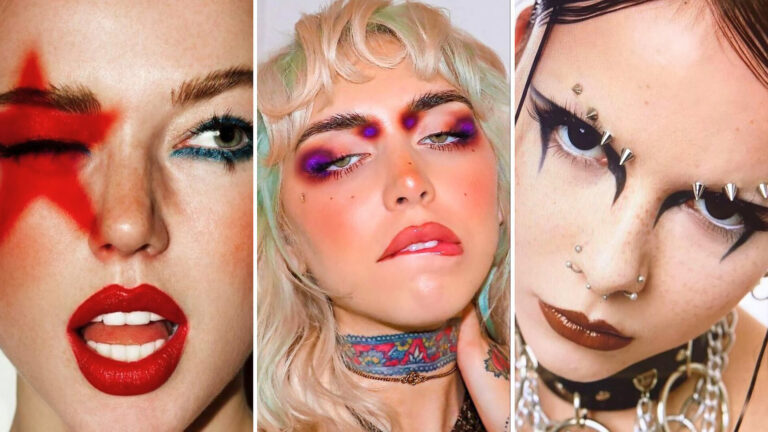
Punk makeup is all about creating bold and edgy looks that defy conventional beauty norms. It is characterized by the use of dark and vibrant colors, heavy eyeliner, and unconventional lip colors.
One of the key aspects of punk makeup is expressing individuality and rebellion. Punk artists and enthusiasts use makeup as a form of self-expression and to challenge societal expectations. They embrace their unique sense of style and use makeup to make a statement.
One iconic punk makeup style is the smudged eyeliner look. This involves applying thick black eyeliner around the eyes and smudging it for a disheveled and rebellious effect. Another popular punk makeup choice is unconventional lip colors such as deep blacks, vibrant blues, or vivid purples. These bold lip colors challenge traditional beauty standards and add an element of rebellion to the overall look.
Punk makeup allows individuals to break free from the constraints of mainstream beauty and embrace their true selves. It is a powerful way to disrupt the status quo and assert one’s individuality. Through bold and unconventional choices, punk makeup reflects the punk ideology of pushing boundaries and challenging societal norms.
Punk Hairstyles
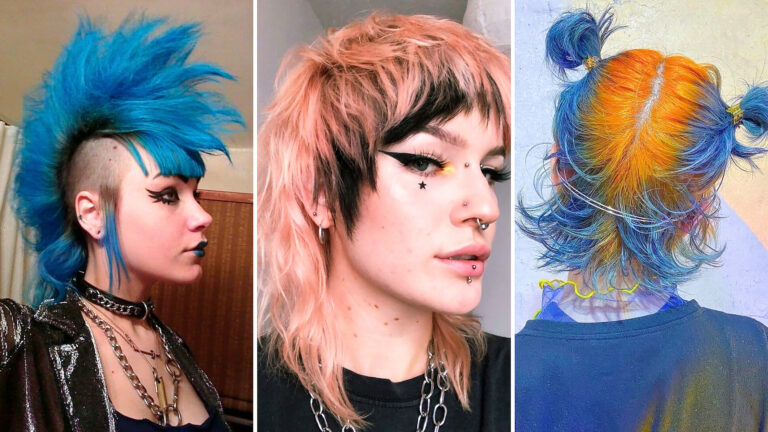
Punk hairstyles are a distinct and rebellious expression of the punk aesthetic, particularly popular among punk girls. These hairstyles defy societal norms and showcase an individual’s unique sense of style.
One iconic punk hairstyle is the mohawk, characterized by a strip of hair down the center of the head, often styled into a spike. Mohawks can be achieved with both short and long hair, and are sometimes dyed in vibrant colors to further enhance the punk look. Shaved sides are another common punk haircut, creating a bold and edgy appearance.
Brightly colored hair is a defining feature of punk hairstyles. From neon pinks and blues to fiery reds and electric greens, punk girls are known for their bold hair hues. These vibrant colors serve as an expression of individuality and rebellion.
Asymmetrical cuts are also prevalent in punk hairstyles. These cuts involve uneven lengths, creating an asymmetrical and unconventional look. This adds an element of uniqueness and nonconformity to the style.
Lastly, spiked hair is a classic punk hairstyle. Achieved by using copious amounts of hair gel or hairspray to create sharp and pointed spikes, this hairstyle exudes a rebellious and defiant attitude.
Punk Nails and Nail Art
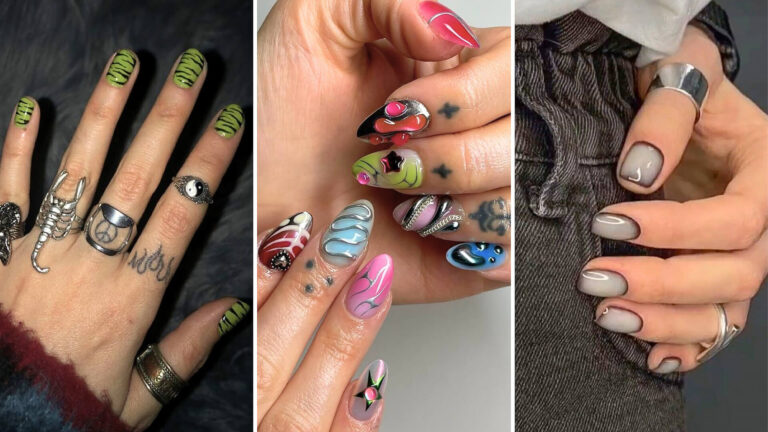
Punk nails and nail art have become an integral part of the punk aesthetic, allowing individuals to express their rebellion and non-conformity through their fingertips. This unique form of self-expression embraces bold colors, edgy designs, and unconventional symbols.
One of the defining characteristics of punk nail art is its vivid and eye-catching colors. From neon pinks and electric blues to fiery reds and pitch-black, punk nails are all about making a statement. These daring hues reflect the punk ethos of standing out and challenging societal norms.
Patterns and symbols play a significant role in punk nail art. Graffiti-inspired designs, leopard prints, and checkerboard patterns are commonly seen on punk nails. Safety pins, studs, and spikes are often incorporated, adding an element of toughness and rebellion. These punk-inspired elements are not only visually striking but also convey a powerful message of defiance.
What sets punk nail art apart is its DIY nature. Similar to the punk ideology in music and fashion, punk nails are often created at home using easily accessible tools and materials. Embracing the do-it-yourself spirit, punk nail art encourages experimentation and individuality.
Tips on How to Create Your Punk Outfit
Creating a punk outfit involves embracing the rebellious and nonconformist spirit of the punk aesthetic. Here are some key tips on how to achieve a punk look:
- Start with the basics: Punk clothing typically consists of ripped jeans, band t-shirts, leather jackets, and plaid shirts. Keep in mind that these items should be worn with an edgy and non-traditional twist.
- Accessorize creatively: Add punk accessories such as studded belts, spiked collars, and wristbands to your outfit. Safety pins, chains, and badges can also be used to customize your clothes and give them a more punk-inspired look.
- Experiment with hair and makeup: Punk hairstyles often feature brightly colored or dyed hair, short and choppy cuts, or bold Mohawks. For makeup, go for smoky eyes, dark lip colors, and bold eyeliner for an edgy and dramatic effect.
- Incorporate gothic elements: Gothic and punk aesthetics often overlap, so don’t be afraid to add some gothic touches to your punk outfit. This can include lace-up boots, fishnet stockings, corsets, or Victorian-inspired accessories.
- Embrace individuality: The punk aesthetic is all about expressing yourself and rejecting societal norms. Don’t be afraid to mix patterns, clash colors, and wear unconventional pieces. Remember, the key is to create a look that reflects your personality and beliefs.
By following these tips and incorporating elements of the punk aesthetic into your outfit, you can create a bold and unconventional punk look that stands out from the crowd.
The Impact of Punk Aesthetic on Fashion
The punk aesthetic has had a profound impact on the world of fashion, challenging traditional norms and introducing bold and unconventional styles. This rebellious subculture not only influenced clothing choices, but also accessories, makeup, hairstyles, and even nail art.
Punk fashion was characterized by its DIY ethos, rejecting mainstream trends and embracing individuality. Safety pins became a staple accessory, used to hold together ripped clothing as a symbol of rebellion. This act of intentional destruction challenged the notion of fashion as status and instead celebrated the raw and authentic.
The use of bold makeup and hairstyles was another significant aspect of the punk aesthetic. Dark and smoky eyes, vibrant hair colors, and bold eyeliner created a striking look that challenged conventional beauty standards. Nail art also became a form of self-expression within the punk subculture, with spiked, studded, or painted nails serving as an extension of the punk ethos.
Iconic punk fashion items include leather jackets, ripped jeans, band t-shirts, and plaid shirts. These pieces reflected the anti-establishment attitude and individualism of the movement. Other notable items included studded belts, spiked collars, and wristbands, which added a touch of rebellious flair.
The impact of the punk aesthetic continues to be felt in fashion today. Designers and influencers draw inspiration from its rebellious spirit, incorporating elements such as ripped clothing and safety pins into their collections. The punk aesthetic remains a powerful force, challenging societal norms and encouraging self-expression through fashion.
Punk Aesthetic in Music & Entertainment
The punk aesthetic had a profound impact on the world of music and entertainment, with punk rock playing a key role in shaping the movement. Punk music challenged traditional norms and introduced a raw, rebellious sound that differed greatly from the polished and mainstream music of the time.
Influential punk bands such as the Sex Pistols and the Ramones were pioneers of the punk aesthetic. The Sex Pistols, hailing from Britain, were known for their provocative lyrics, energetic performances, and anarchic attitude. Their music and image embodied the anti-establishment ethos of punk, with their album “Never Mind the Bollocks, Here’s the Sex Pistols” becoming a punk rock anthem.
The Ramones, on the other hand, emerged from the United States with their fast-paced, stripped-down sound. With their catchy melodies, simple guitar riffs, and leather jackets, they became synonymous with the punk aesthetic. The Ramones’ influence can still be felt in punk and rock music today.
The punk aesthetic and its music scene provided a platform for artists to express themselves freely and challenge societal norms. It united individuals who felt disillusioned with mainstream culture and offered them a sense of community. The DIY spirit of punk also led to the rise of independent record labels, creating opportunities for bands outside of the mainstream to thrive.
Punk Aesthetic in Movies and Cinematography
The punk aesthetic has had a significant impact on movies and cinematography, translating its rawness and rebelliousness onto the big screen. The visual style of punk, with its gritty and DIY elements, has greatly influenced the themes and aesthetics of punk-inspired films.
Punk cinematography often embraces a low-budget and guerrilla-style approach, reflecting the DIY ethos of the punk movement. This can be seen in the use of handheld cameras, grainy footage, and unconventional editing techniques. These elements contribute to creating an authentic and visceral portrayal of punk culture on screen.
Notable movies that embody the punk aesthetic include “Sid and Nancy” (1986), directed by Alex Cox, which explores the tumultuous relationship between Sid Vicious of the Sex Pistols and Nancy Spungen. The film captures the anarchic energy of the punk scene and portrays the self-destructive nature of the punk ethos.
Another example is “Repo Man” (1984), directed by Cox as well, which follows a young punk who becomes a repo man and gets involved in a hunt for a mysterious car. The film’s visual style, with its neon-lit streets and punk-inspired soundtrack, exemplifies the rebelliousness and countercultural spirit associated with punk.
The punk aesthetic in movies continues to shape the portrayal of punk culture and its subversive themes. By capturing the rawness and energy of the punk movement, these films provide audiences with an authentic glimpse into the world of punk, pushing cinematic boundaries and challenging conventional norms.
The Punk Aesthetic in Interior Design
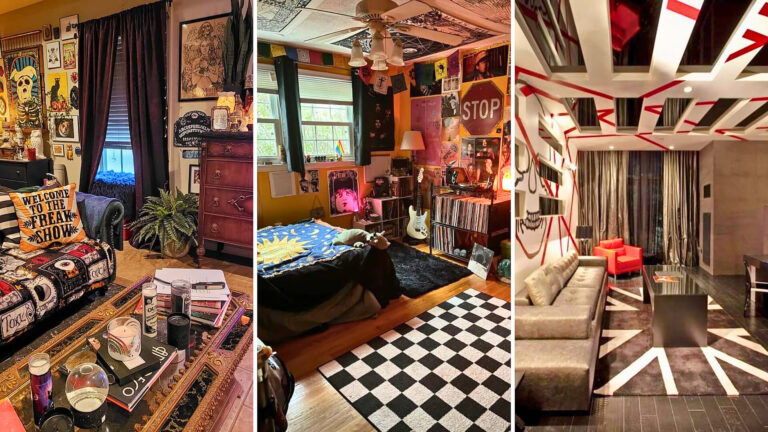
The punk aesthetic is not limited to fashion and music; it can also be incorporated into interior design to create a bold, rebellious, and unconventional living space. Punk-inspired interior design embraces a unique and edgy style that rejects traditional norms and embraces individual expression.
One of the key characteristics of the punk aesthetic in interior design is the use of bold colors. Vibrant shades like electric blue, neon green, and fiery red are often used to create a visually striking and energetic atmosphere. These colors are often combined in unconventional ways to create a sense of chaos and rebellion.
Industrial materials are another important element of punk-inspired interior design. Exposed brick walls, metal finishes, and concrete floors add a raw and gritty feel to the space. This industrial aesthetic reflects the do-it-yourself (DIY) ethos of punk, as these materials are often associated with repurposing and upcycling.
Unconventional furniture and decor also play a significant role in punk-inspired interior design. Repurposed materials like old car parts or reclaimed wood are used to create unique and one-of-a-kind furniture pieces. Distressed leather sofas, vintage posters, and graffiti art are common elements that add a sense of rebellion and street culture to the space.
Punk interior design embraces the concept of repurposing and upcycling. Instead of conforming to traditional design standards, punk design encourages the use of found objects and DIY accents. This not only adds a personal touch to the space but also promotes sustainability and eco-consciousness.
Future of the Punk Aesthetic Beyond 2024
The future of the punk aesthetic beyond 2024 is likely to continue shaping fashion, art, and music with its rebellious and DIY spirit. As a subculture that values individualism, the punk aesthetic will inspire emerging trends and subcultures that challenge societal norms and push creative boundaries.
In fashion, we can anticipate a fusion of punk elements with other styles, resulting in innovative and eclectic fashion statements. For instance, punk-inspired streetwear may incorporate elements of high fashion, creating a unique blend of rebellion and sophistication. Moreover, the ongoing impact of established punk elements, such as safety pins and leather jackets, will persist as iconic symbols of rebellion in popular culture.
In the art world, we can expect punk aesthetics to continue influencing artistic expressions. Artists may combine graffiti art, mixed media, and unconventional materials to create thought-provoking and raw pieces. The punk ethos of challenging the status quo and questioning authority will fuel artistic movements focused on social activism and political commentary.
In music, the punk aesthetic will inspire new genres and subcultures that deviate from mainstream conventions. This may involve the integration of punk elements with various musical styles, leading to the emergence of exciting hybrid genres. The punk ideology of individual freedom and direct action will continue to influence musicians and audiences alike, fueling a diverse and vibrant music scene.
Overall, the future of the punk aesthetic holds immense potential for groundbreaking innovations and interpretations in fashion, art, and music. It will continue to captivate and inspire creatives who value authenticity, self-expression, and a defiance of societal norms.
